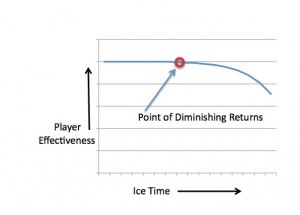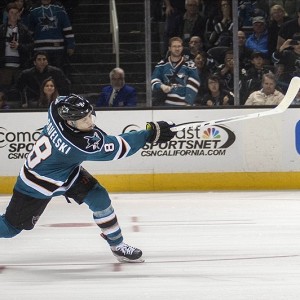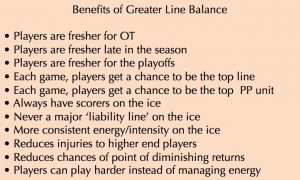One of the favorite pastimes of NHL followers is to suggest and debate line combinations for their favorite teams; which player should be with which other players on the forward lines. If you have 12 forwards, all interchangeable, you can form over 200 different line combinations. With 13 or 14 forwards to choose from, the number of combinations goes up even further.
A simple approach to determining line combinations would be to take the three most talented forwards from the group of 12, put them on the top line and give them the most ice time. From the remaining nine forwards, take the three who are most talented to form the second line and give that line the second most ice time. Follow that procedure until there are four lines. This process would produce forward lines that can be considered top-heavy, the better talent is only the top lines.
In the course of this article, I will quantify line balance. I will use examples that feature the San Jose Sharks because it is the team I am most familiar with. But this approach and the arguments are applicable to any team.
I will admit my bias upfront. In a generic sense, I favor more balanced lines than most teams decide to use, certainly more than the Sharks have used in recent seasons. That said, I’m not dogmatic about it, the object of hockey is not to come up with some perfect line balance. The object is to win games, make the playoffs and win in the postseason. Line balance can help, or hinder that effort.
The Drawbacks of Top-Heavy Lines
 The top-heavy approach, where most of the talent is placed in one or two lines, has several drawbacks. To start, while a team may have one very good line, a team can not afford to have depleted lower lines because they will also need to play a considerable amount of time. Whatever advantages the talent-heavy top line might offer, the talent-light bottom lines — I call them ‘liability lines’ — might give back.
The top-heavy approach, where most of the talent is placed in one or two lines, has several drawbacks. To start, while a team may have one very good line, a team can not afford to have depleted lower lines because they will also need to play a considerable amount of time. Whatever advantages the talent-heavy top line might offer, the talent-light bottom lines — I call them ‘liability lines’ — might give back.
Top-heavy lines can lead to a substantial imbalance in time-on-ice. Hockey is a very physically demanding sport and ice time adds up over the course of a game and over the course of a season. Players with excessive ice time can reach the point of diminishing returns, both within a game and over the course of a season, especially into the playoffs. Two years ago, Justin Williams won the Conn Smythe as the MVP of the playoffs. Williams was not even close to the most talented player on the LA Kings, but he benefited from having logged considerably less ice time during the regular season than his team’s top players. By balancing lines, good players can play fewer minutes during the course of a game, meaning they can play more aggressively without worrying about managing their energy level during a game. Over the course of a season, players can expect to have more energy as well.

One can manage a player’s ice time to avoid reaching his point of diminishing returns. Diminishing returns can be considered both in the context of a single game and over the course of a season.
Another factor is injury. Reducing minutes for top players means less opportunity to get injured. It also makes it less likely to exacerbate an injury issue. Good players play hurt, they are simply too valuable to keep out of the line-up. But it takes a toll. Hockey is especially unforgiving, with its short offseason. In NFL football, the championship teams have seven months between meaningful games, in the NHL it is just four months. With limited opportunity to recover between games and even in the offseason for more significant injuries, lowering the risk profile associated with injuries can make a difference.
Using more balanced lines, one can expect a team to be healthier, fresher and stronger relative to competitors late in games. One can expect a team to be healthier, fresher and stronger relative to competitors as the season goes on. Being healthier, fresher and stronger than your opponent is good in Game 1, but it is huge in Game 83. Since the object is to win games, make the playoffs and win in the postseason, using more balanced lines can play a meaningful role in meeting these objectives.
Balancing lines means a team will never be at a significant disadvantage at any point during 5-on-5 play. I think of hockey as a game that is defensively biased, that is a pretty good defensive player can usually stop a very good offensive player. If the offensive ability of a player is modestly better than his defender’s ability, the puck is unlikely to wind up in the net. However, when there is a significant mismatch between the talent of the offensive player and their defender, the chance for a score goes up dramatically. If a team never puts out a weak line, it is never at a major disadvantage.
Chemistry is a major issue as well. How players work with others determines a lot about how a coach might go about setting lines. In the case of the Sharks, Joe Thornton helped transform a very modest talent, Devin Setoguchi, into a 30 goal scorer. Thornton doesn’t need great players around him to be productive. For most of the past two seasons, Thornton has had the highly skilled Joe Pavelski on his wing. But would splitting them up improve the team’s overall play? One could argue that Pavelski’s most effective time was not on a top line or even a second line, but on a third line with a pair of very modest players: Kyle Wellwood and Torrey Mitchell. From February 1 through April 9 of 2011, Pavelski’s line was dominant. He averaged over a point per game and was a staggering +24 in that period. Pavelski is a top line talent, but moving his talent to a lower line enabled a mismatch that gave the Sharks a large and sustainable advantage.
A Systematic Approach to Line Balancing
I am proposing a method to look at line balance. The system begins by ranking the forwards, from best to worst, one through 12. In prior articles, my THW colleagues Andrew Bensch and Drew Weber predicted the scoring totals for the upcoming season for the Sharks top 12 (healthy) forwards. I will rank them from 1-12 in the order of points predicted. Obviously, scoring is not the whole story of how a player should rank, but to illustrate the process, it serves the purpose.
- Joe Pavelski
- Joe Thornton
- Patrick Marleau
- Logan Couture
- Tomas Hertl
- Tommy Wingels
- Joel Ward
- Chris Tierney
- Matt Neito
- Melker Karlsson
- Barclay Goodrow
- Ben Smith
The ranking assigns each player a numerical value, Joe Pavelski, the top ranked player, is assigned a value of 1. Joe Thornton, the second ranked player, is assigned a value of 2. And so forth. The average value of a player on this list is 6.5. The average value of a 3-player line will be 3*6.5 or 19.5. One can look at line balance by determining how far away a line is from the mean of 19.5.

Last season, the Sharks rolled Thornton, Pavelski and Karlsson as the top line for a good part of the season. In this case, the line’s value would be 2+1+10=13. That is 6.5 from the mean of 19.5. The second line often featured Couture, Marleau and Wingels. In this case, 4+3+6=13. Both those two lines were 6.5 below the mean. The bottom two lines will average 6.5 above the mean, or a line value of 26. One might consider a third line of Hertl, Tierney and Ward from this group, or 5+8+7=20. Meaning the fourth line would be Nieto, Goodrow and Smith, or 9+11+12=32.
The maximum line value is 33, the minimum line value is 6. When the Sharks rolled with a line of Brent Burns, Thornton and Pavelski a couple of seasons back, one could have argued that line was 1+2+3=6, the most top-heavy a line can be using this process.
In order to assess balance, one can look at how far each line deviates from the mean of 19.5. A very balanced set of lines might range from a maximum of 22 to a minimum of 17, +/-2.5 from the mean.
Let’s take a look at what a group of lines that fits that criteria might look like:
Marleau, Smith, Ward (22)
Thornton, Hertl, Karlsson (17)
Couture, Tierney, Nieto (21)
Pavelski, Wingels, Goodrow (18)
These lines are indeed, quite balanced. On any given night, one could imagine any of these lines being a top line, and any of these being the bottom line. Each line features scoring talent, meaning the Sharks would have at least one scoring threat during all 5v5 play.
Loosening up the range to +/-4.5 means each line will have a line value between 15 and 24. This provides less balance, though the lines are still pretty balanced. Here are some line combinations that would fit this criteria.
Thornton, Marleau, Karlsson (15)
Pavelski, Wingels, Goodrow (18)
Hertl, Ward, Nieto (21)
Couture, Smith, Tierney (24)
Looking at these lines, the Sharks would always have a competitive group on the ice. The nominal ‘fourth line’ on this ranking system (Couture, Smith and Tierney) could hold its own against almost any line in hockey. It would be a wrecking crew against the fourth lines of pretty much any other NHL team.
Trying to distill the overall line balance to a single number is not hard. The most obvious number is the range, max-min, which is easy to calculate. For the Sharks last season, the range was typically over 15, often close to 20. It might be more accurate to use a measure like the standard deviation of the four line values, though it would not be as easily calculated nor would it be intuitive to most people.
Variations on the Theme

There are all sorts of variations on this basic theme. One could weigh players differently. Instead of using a ranking, one could measure a player on a scale (1-10) and use that value in the balancing equation. Another ranking approach is to give players monetary value, similar to how players are ranked in fantasy leagues.
It can also be interesting to look at line balance in terms of salary cap spending. The projected second line for the Sharks consists of Marleau, Ward and Couture (line value=13). The cap spending on that line is nearly $16million. The third line is forecast to be Hertl, Wingels and Nieto (line value=20), with a cap hit a bit under $4.2million. It makes no sense to determine lines based on the players cap hit, but it can offer a connection between cost and value, which matters when it comes to contracts, trades, etc.
Balancing Opportunities and Considerations
Ultimately, a ranking system would be done by the coach. For the Sharks, the values used here would likely not be the ranking that Peter DeBoer and his staff would come up with. I should reiterate that Andrew and Drew did not attempt to rank the players in their analyses, just forecast point totals. Their analyses were simply a handy starting point for this exercise.
Employing this sort of system can help guide a coach, but it is not intended to be employed in a rigorous manner. A player might be ranked lower if he is dealing with an injury. Likewise, a player can be ranked higher if they improve their game. Rankings are not set, but fluid. Further, some players play well with others, some do not. Chemistry matters and you can get a line that might nominally appear below average, yet performs well above average (the aforementioned line of Pavelski, Mitchell and Wellwood is one such example). Further, during the course of a game, a team may wind up losing a forward for a time and adjustments will be required. Lines can be juggled to find better chemistry or performance within a game. Any attempt to be overly rigorous would quickly conflict with reality.

Using highly balanced lines can lead to some interesting options during games. There can be in-game competition for minutes. For example, the coach can roll all four lines equally through the first two periods, then rank them for the final period. The bottom line that night might roll only half the shifts of the top three lines in that final period. A coach could also decide to award the top performing line top power play minutes, with the second best line getting the second power play minutes. Having these sorts of in-game incentives can help players stay motivated over the long season.
The system does not require the coach to keep the same boundary over the course of the season. A coach could start the season targeting a line value range of 10, then move to a range of 14 in December and 16 in February.
I would like to see lines more balanced for the first 50 or so games, then come the stretch drive, to start weighting more minutes to the better players. Line balance becomes an even smaller issue in the playoffs. Playing for the optimal result of an 82 game season differs from trying to win a seven game series. The chart below captures the benefits of line balance described in this article.
For the Sharks, there is an added dimension in all this. The team’s two highest paid players are both 36 for this upcoming season. The talent may still be there, but expecting these two players to play big minutes and not fade over the course of the season is a stretch. Last season can offer a guide. In the first half of the season (the 2014 portion), they combined to be +1. In the second half (the 2015 portion of the season), a combined -23. These two players clearly delivered diminishing returns in the second half of the year.
Balanced. Or Not
This systematic approach is available to every team in hockey. I used the Sharks (the team I am most familiar with) to illustrate the process. One can use this ranking technique to determine the level of balance a team applies to its forward lines.
A coach can intentionally decide to be unbalanced, believing this is the best approach for their team. There are arguments to be made for that approach. Very successful teams have paired top talents on their top lines. Anaheim has played Ryan Getzlaf with Corey Perry. Chicago has played Jonathan Toews with Patrick Kane. It is hard to argue with their results.
Most importantly, we have a method to quantify how balanced a teams lines are. Fans can look at their own team, rate their forwards and do the simple math. When a person rolls out their own suggested line combinations, they can quantify the line balance associated with them by looking at the line value.
For years, we have heard the phrase that the NHL ‘is a four-line league’. This is a method that can help fans tell if their team believes it. Or not.
